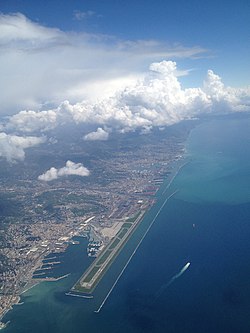Genoa airport
| Genoa airport | |
|---|---|

|
|
| Characteristics | |
| ICAO code | LIMJ |
| IATA code | GOA |
| Coordinates | |
| Height above MSL | 4 m (13 ft ) |
| Transport links | |
| Distance from the city center | 6 km west of Genoa |
| Street | A10 |
| Basic data | |
| opening | 17th July 1985 |
| operator | Aeroporto di Genova Spa |
| surface | 160 ha |
| Passengers | 1,536,136 (2019) |
| Air freight | 2,694.6 t (2019) |
| Flight movements |
20,645 (2019) |
| Start-and runway | |
| 10/28 | 2915 m × 45 m asphalt |
The Genoa airport ( Italian Aeroporto di Genova-Sestri "Cristoforo Colombo" , IATA code : GOA , ICAO code : LIMJ ) is an Italian airport in Genoa .
It is the most important airport in Liguria and named after the discoverer Christopher Columbus .
Directions
Car : The airport is 7 km west of the city center in the Sestri Ponente district .
Bus : The AMT 100 Volabus runs from Piazza Verdi ( Genova Piazza Principe train station ) to the airport (every hour). From Genova Sestri Ponente Aeroporto train station , line I24 leaves for the airport every 40 minutes.
history
The beginning of aviation in Genoa is closely linked to Ansaldo and Piaggio . During the First World War , today's Piaggio Aerospace in Sestri Ponente produced aircraft parts under license , and in 1923 they began building their own aircraft. Flying boats were also made. These soon played an important role in the emerging civil service in Italy. In January 1925, the airline SANA ( Società Anonima di Navigazione Aerea ) was founded in Genoa , and from 1926 its flying boats flew to various destinations in the Mediterranean from the city's large port . From 1929 the British Imperial Airways used the port as a stopover on the route between London and Karachi . After the Second World War , it was decided to create an artificial peninsula in the harbor basin and to build a commercial airport for the city there. Work began in 1954 and the inauguration took place in 1962. The runway was initially around 2,300 meters long, and there were also simple handling facilities . With the completion of the new terminal in 1986, Genoa also took on the role of an alternate airport for some airports in the northern Italian Po Valley , which often had to be closed due to fog .
Special features and information for pilots
For reasons of noise protection, the RWY 28 is preferred for landings and take-offs. In the north, west ( Ligurian Alps ) and east ( Apennines ) the course is surrounded by larger elevations, while the Ligurian Sea lies in the south . On the square, north of the landing threshold RWY 10, is the Sestri- VOR (108.6 MHz). The ILS for RWY 28 (109.3 MHz) allowed approaches the category CAT I . The instrument approach to the RWY 28 begins at the Initial Approach Fix (IAF) Camogli- NDB (389 kHz). The NDB stands approx. 15 NM from the RWY 28 threshold as an extension of the approach line. The Standard Departure Routes ( SIDs ) head south out to sea first to gain altitude.
Incidents
- A Dornier 328-110 (D-CPRR) had an accident on February 25, 1999 . The Minerva Airlines machine , which was operated for Alitalia , shot over the end of the runway when landing at Genoa Airport , among other things because it landed with an inadmissibly strong tailwind and touched down much too late. Four people were killed (see also Alitalia flight 1553 ) .
Web links
- airport.genova.it Official website (Italian / English)
Individual evidence
- ↑ a b c Statistiche December 2019. In: assaeroporti.com. Assaeroporti , accessed April 26, 2020 (Italian).
- ↑ Lufthansa airport map (as of March 2006).
- ^ Accident report Dornier 328 D-CPRR , Aviation Safety Network (English), accessed on March 12, 2020.